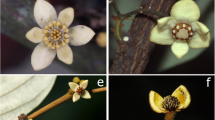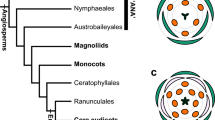Abstract
Pseudanthia occur in more than 40 angiosperm families. With regard to the underlying inflorescence structure they can be classified into the following groups: (a) floral and (b) hyperfloral pseudanthia, each with (c) or without (d) pseudocorollas. Pseudanthia have developed along independent evolutionary lines and are not bound to a particular inflorescence structure. They are the result of (a) the specific morphological predisposition of the taxon concerned, (b) aggregation and diminution of the flowers, giving rise to the formation of an attraction unit (for animal pollination), (c) variation, and (d) selection. Ontogenetical abbreviation is regarded to play an essential role in the origin and elaboration of pseudanthia.
Similar content being viewed by others
References
Andersson, L., 1981: The neotropical genera ofMarantaceae. Circumscription and relationships. — Nordic J. Bot.1: 218–245.
Armbruster, S., Webster, G. L., 1979: Pollination of two species ofDalechampia (Euphorbiaceae) in Mexico by Euglossine bees. — Biotropica11: 278–283.
Briggs, B., Johnson, L. A. S., 1979: Evolution in theMyrtaceae. Evidence from inflorescence structure. — Proc. Linn. Soc. New South Wales102: 157–272.
Classen, R., 1984: Untersuchungen zur Struktur und Phylogenie von Pseudanthien unter besonderer Berücksichtigung ihrer Analogie zu zoophilen Einzelblüten. — Dissertation, Aachen, Rheinisch-Westfälische Technische Hochschule.
, 1986: Organisation und Funktion der blumenbildenden Hochblatthüllen beiSymphoremoideae (Verbenaceae). — Beitr. Biol. Pflanzen60: 383–402.
, 1987: Morphological adaptations for bird pollination inNicolaia elatior (Jack)Horan (Zingiberaceae). — Gard. Bull. Sing.40: 37–43.
, 1988: Beiträge zur Kenntnis der GattungLasiopetalum (Sterculiaceae). — Bot. Jahrb. Syst.109: 501–527.
Classen-Bockhoff, R., Armstrong, J. A., Lehne, M., 1990: The inflorescences of the Australian generaDiplolaena andChorilaena (Rutaceae). — Austral. J. Bot. (in press).
- 1991: Florale Differenzierung in komplex organisierten Asteraceenköpfen. — Flora (in press).
Dahlgren, R. M. T., 1980: A revised system of classification of the angiosperms. — Bot. J. Linn. Soc.80: 91–124.
Docters Van Leeuwen, W. M., 1927: Vogelbloemen: 3.Rhodoleia teysmanni Miq. — De Trop. Natuur16: 2–6.
Drenth, E., 1972: A revision of the familyTaccaceae. — Blumea20: 367–406.
Dressler, R. L., 1957: GenusPedilanthus (Euphorbiaceae). — Contr. Gray Herbarium182: 1–188.
Endress, P., 1970: Die Infloreszenzen der apetalen Hamamelidaceen, ihre grundsätzliche morphologische und systematische Bedeutung. — Bot. Jahrb.90: 1–54.
, 1977: Evolutionary trends in theHamamelidales-Fagales-group. — Pl. Syst. Evol. Suppl.1: 321–347.
Froebe, H. A., 1964: Die Blütenstände der Saniculoideen (Umbelliferae). Eine vergleichendmorphologische und entwicklungsgeschichtliche Untersuchung. — Beitr. Biol. Pflanzen40: 325–388.
, 1979: Die Infloreszenzen der Hydrocotyloideen (Apiaceae). — Trop. Subtrop. Pflanzenwelt40: 325–388.
, 1980: Randmusterbildung und Synorganisation bei strahlenden Apiaceendolden. — Pl. Syst. Evol.133: 223–237.
, 1978: Pseudanthien bei Umbelliferen. — Beitr. Biol. Pfl.54: 175–206.
, 1983: A re-evaluation of the inflorescence ofDalechampia spathulata (Scheidw.)Baillon (Euphorbiaceae). — Bot. Jahrb. Syst.104: 249–260.
Goebel, K., 1931: Blütenbildung und Sproßgestaltung. — Jena: Fischer.
Good, R., 1956: Features of evolution in the flowering plants. — London: Longmans.
Harling, G., 1946: Studien über den Blütenbau und die Embryologie der FamilieCyclanthaceae. — Svensk Bot. Tidskr.40: 257–272.
Hoppe, J., 1985: Die Morphogenese der Cyathiendrüsen und ihrer Anhänge, ihre blatttypologische Deutung und Bedeutung. — Bot. Jahrb. Syst.105: 497–581.
, 1982: Morphogenese und typologische Interpretation des Cyathiums vonEuphorbia-Arten. — Beitr. Biol. Pflanzen56: 63–98.
Ihlenfeldt, H.-D., 1971: Über ontogenetische Abbreviationen und Zeitkorrelationsänderungen und ihre Bedeutung für Morphologie und Systematik. — Ber. Deutsch Bot. Ges.84: 91–107.
Jahnke, C., 1986: Der Infloreszenzbau der Cornaceen sensu lato und seine systematischen Konsequenzen. — Trop. Subtrop. Pflanzenwelt57: 569–710.
Johow, F., 1884: Zur Biologie der floralen und extrafloralen Schauapparate. — Jahrb. Königl. Bot. Gart. Berlin3: 47–68.
Kaussmann, B., 1951: Morphologisch-anatomische Studien anSchizocapsa. — Planta39: 91–104.
Kunze, H., 1985: Die infloreszenzen der Marantaceen und ihr Zusammenhang mit dem Typus derZingiberales-Synfloreszonz. — Beitr. Biol. Pfl.60: 93–140.
Leppik, E. E., 1969: Morphogenetic classification of flower types. — Phytomorphology18: 451–466.
Maresquelle, H. J., 1970: Le théme évolutif des complexes d'inflorescences. Son aptitude a susciter des problèmes nouveaux. — Bull. Soc. Bot. France117: 1–4.
Michaelis, P., 1924: Blütenmorphologische Untersuchungen an den Euphorbiaceen. — Bot. Abh. 3. — Jena: G. Fischer.
Porsch, O., 1923: Blütenstände als Vogelblumen. — Österr. Bot. Z.6–8: 125–149.
Rourke, J. P., 1984: A revision of the genusMimetes Salisb. (Proteaceae). — J. S. African Bot.50: 171–236.
Rousseau, F., 1976: TheProteaceae of South Africa. 3rd edn. — Cape Town: Purnell.
Rutishauser, R., 1983:Hydrothrix gardneri: Bau und Entwicklung einer eigenartigen Pontederiacee. — Bot. Jahrb. Syst.104: 115–141.
Sell, Y., 1976: Tendances évolutives parmi les complexes inflorentiels. — Rev. Gen. Bot.83: 247–267.
Struik, C., (Publ.), 1987: Wildflowers of South Africa. — Cape Town: Struik.
Takhtajan, A., 1959: Die Evolution der Angiospermen. — Jena: VEB G. Fischer.
Troll, W., 1928: Organisation und Gestalt im Bereich der Blüte. — Berlin: Springer.
, 1954: Die Infloreszenzen. Typologie und Stellung im Aufbau des Vegetationskörpers. 1. — Jena: VEB G. Fischer.
Vogel, S., 1964: Blütenbiologische Typen als Elemente der Sippengliederung. — Bot. Stud.1: 1–338.
, 1968: Chiropterophilie in der neotropischen Flora. Neue Mitteilungen 1. — Flora, Abt. B,157: 562–602.
Weberling, F., 1977: Beiträge zur Morphologie der Rubiaceen-Infloreszenzen. — Ber. Deutsch. Bot. Ges.90: 191–209.
, 1981: Morphologie der Blüten und Blütenstände. — Stuttgart, Ulmer.
Author information
Authors and Affiliations
Additional information
Full-length version of a paper read at the 14th International Botanical Congress, Berlin 1987, Symposium 4–19.
Rights and permissions
About this article
Cite this article
Classen-Bockhoff, R. Pattern analysis in pseudanthia. Pl Syst Evol 171, 57–88 (1990). https://doi.org/10.1007/BF00940596
Received:
Revised:
Issue Date:
DOI: https://doi.org/10.1007/BF00940596




